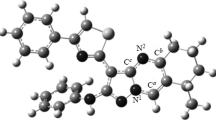Abstract
IT is now known that all substances of the form (I), in which A is a saturated hydrocarbon residue, are yellow, fluorescing blue or violet in benzene or ethereal solution, and blue-green, or green, in hydroxylic solvents. 
Similar content being viewed by others
References
Bucherer and Grolée, Ber. deut. chem. Ges., 39, 991 (1906).
Plancher and Bettinalli, Gazetta, 29, 1, 115 (1899).
Betts, Muspratt and Plant, J. Chem. Soc., 1311 (1927).
Perkin and Plant, J. Chem. Soc., 123, 676 (1923).
Blount, Perkin and Plant, J. Chem. Soc., 1975 (1929).
Beer, McGrath, Robertson and Woodier, Nature, 164, 363 (1949).
Author information
Authors and Affiliations
Rights and permissions
About this article
Cite this article
PLANT, S., ROBINSON, R. Revision of the Structural Interpretation of the Reactions and Properties of Certain Derivatives of Tetrahydrocarbazole and Related Compounds. Nature 165, 36–37 (1950). https://doi.org/10.1038/165036a0
Issue Date:
DOI: https://doi.org/10.1038/165036a0
- Springer Nature Limited
This article is cited by
-
Chemical contributions to the mechanism of the biological oxidation of tryptophan
Experientia (1952)
-
Revision of Structural Interpretations among Tetrahydrocarbazole Derivatives
Nature (1950)
-
Mechanism of the Rearrangement of Quinamine to IsoQuinamine
Nature (1950)
-
Some novel aspects of the chemistry of hydroxyindolenines
Experientia (1950)





